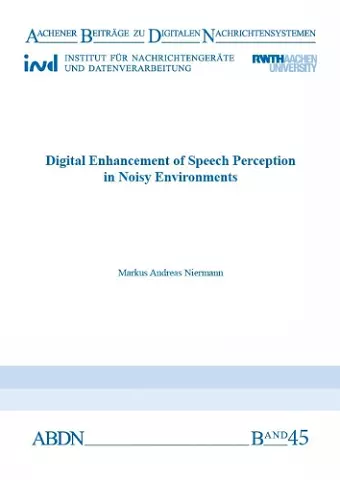Digital Enhancement of Speech Perception in Noisy Environments
Format:Paperback
Publisher:Verlag G. Mainz
Published:7th Mar '19
Should be back in stock very soon

In many everyday situations, people try to listen to speech from a loudspeaker, but the speech perception is affected by background noise. The location of a listener is called the near-end. Some applications in which this problem arises are mobile phones, public address systems, car entertainment systems, hearing aids, or head phones. Depending on the application, the speech may either be a recording, or, in case of communication systems, it may come live from a person speaking at the so-called far-end. Although it is usually not possible to cancel the near-end noise source, the speech perception can be enhanced nevertheless by adaptively pre-processing the loudspeaker signal. To find out in which way the speech should be pre-processed, it is beneficial to know the near-end noise characteristics and take them into account. The knowledge can be gained from a near-end microphone that is located close to the listener. This pre-processing technique is called Near-End Listening Enhancement (NELE). In this work several NELE concepts are developed and studied with the goal of enhancing the speech perception. Afterwards, a computationally very efficient and real-time capable NELE algorithm is developed, which can be implemented on signal processors and integrated into low-power devices.
When deploying these enhancement concepts, additional problems may arise depending on the application. Two of them are studied in detail:
1. If the near-end loudspeaker and microphone are placed close to each other, which might occur at public address systems for instance, the speech from the loudspeaker is coupled into the near-end microphone as crosstalk and disturbs the estimation of the noise characteristics. An analysis of this arrangement shows that the functionality of the NELE algorithm is strongly affected. As a solution, it is proposed to use a new noise estimation technique which provides significantly more accurate noise estimates than state-of-the-art approaches by taking the adaptively predicted crosstalk into account.
2. Especially in the case of mobile communication, it is possible that a noise source is present also at the far-end. Consequently, the speech signal from the far-end is disturbed by noise. Typical mobile phones attenuate the far-end noise by employing techniques of noise reduction (NR) before transmitting the signal to the near-end. At the receiving near-end device, the denoised speech signal would then be processed by...
ISBN: 9783958862685
Dimensions: unknown
Weight: 240g
162 pages